How to create and use mailing list segments
Segmentation helps you take into account the engagement and preferences of your recipients to work with each of them individually.
You can select contacts by statistics of opens and clicks to create activation campaigns. Segmentation allows you to create campaigns that are exclusive to a specific domain or carrier. Likewise, you can use segmentation based on subscribers’ demographics. Send campaigns separately to men and women living in different cities, who prefer different products, congratulate them on their birthday, and so on.
To create a segment, go to the Mailing list tab, choose the required mailing list, and go to the Segments tab.
Click Add segment.
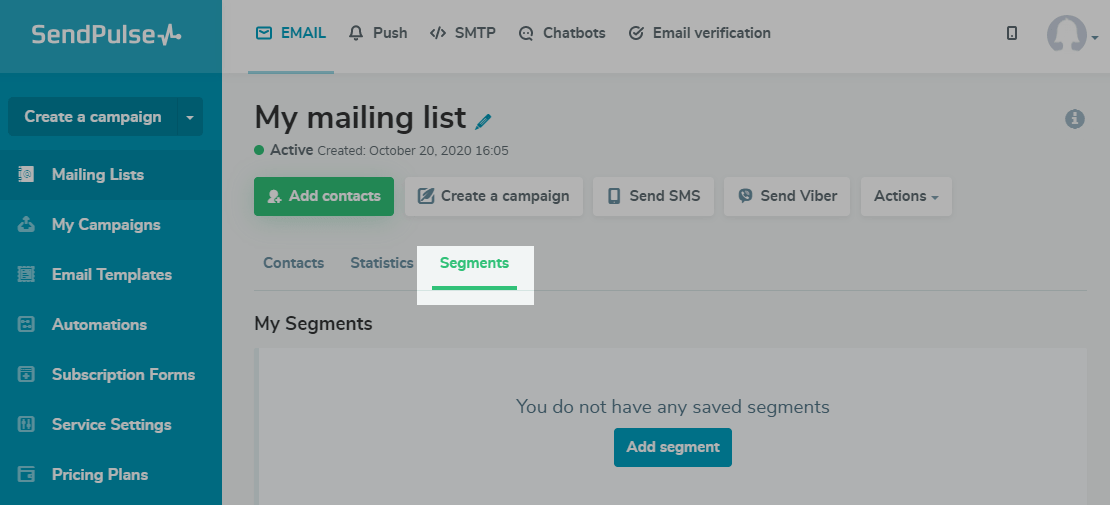
In the pop-up window, set the segmentation conditions.
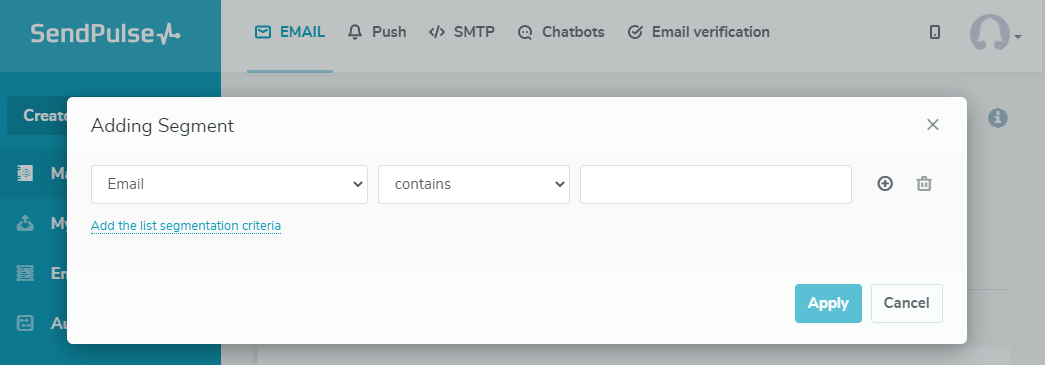
In the first drop-down list, select the segment type - by which criterion to filter; in the second - the filtering condition; and in the third, enter the desired value or select it from the list.
If you want to use several conditions, you can connect them with the operators at the top of the window after adding your segments.
The segmentation feature only uses data for the last 3 months since the date when contacts were created, variables were added, or mailing list statistics were collected. If there are no data points for this period, the segmentation criteria from the "Previous campaigns" section will not be available.
You will find more details about each element in the article below. Use the content list for faster navigation.
Segments types
Criteria by email
Use to select the segments below with filter subscribers using the Email variable.
Selecting Email searches both parts of the email address example@domain.com.
Email: domain part
The domain part of an email address is the part of the address after the @ sign. For example, in the address example@gmail.com, the domain part is gmail.com.
The search will be performed on this part of the email address.
Email: local part
The local part of an email address is the part before the @ sign. For example, for example@domain.com, the local part is example. The search will be performed on this part of the email address.
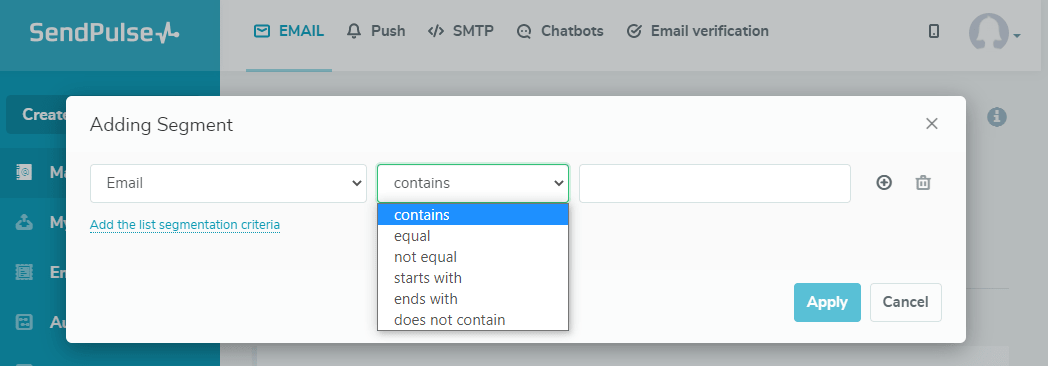
For the criteria Email, Email: domain part, and Email: local part, you can specify the following operators:
| Contains | Search for an email address or a selected part of an email address that contains the value you entered; used for partial matches. |
| Equal | Search for a complete match for the entered value. |
| Not equal | Search for all addresses (the selected part of the address) that do not contain the value you entered; used for a complete match. |
| Starts with | Search for an address (selected part of the address) that starts with the entered value. |
| Ends with | Search for an address (selected part of the address) that ends with the entered value. |
| Does not contain | Search for an address (the selected part of the address) that does not contain the value you entered; used for a partial match. |
Email: status
Use to search for active and inactive email addresses.
SendPulse does not send emails to inactive addresses (all contacts that do not have the Active or New status). Inactive contacts include invalid email addresses and unsubscribed users. Any other statuses are simply for your own records and are not used for segmentation.
To move or delete these subscribers, we recommend using the inactive contacts management tool.
To create a segment, you can select the condition > (equal) or ≠ (not equal) to the selected status.
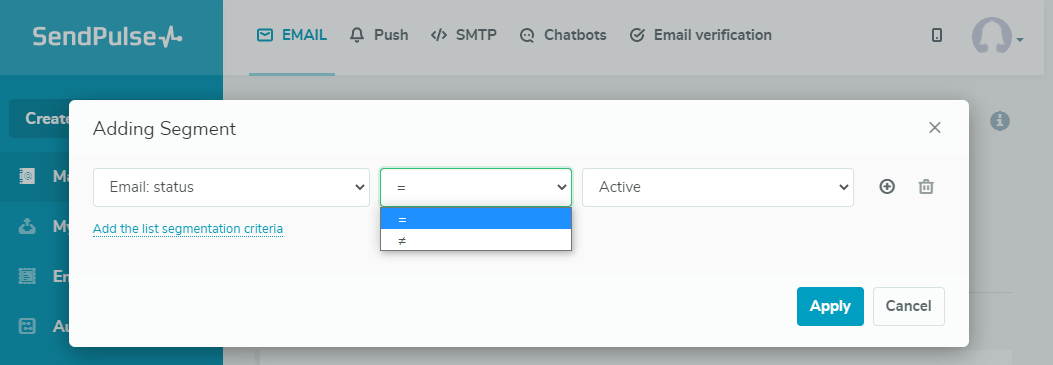
The User has requested deletion of personal data status is assigned if you sent an email with a subscription data management variable and the user selected "Send a request to delete data" in the form.
Email: date added
Used to search for contacts by the date they were added to the selected mailing list. You can choose the following operators:
| After | Search for all addresses added after the selected date. |
| Before | Search for all addresses added before the selected date. |
| Equal | Search for addresses added on a specific date. |
| Between | Search for addresses added in the specified time period. |
| Last N days | Search for contacts that were added to the mailing list for the specified number of days ago. |
| More than N days | Search for contacts that were added to the mailing list more than the specified number of days ago. |
| From M to N days | Search for contacts that were added within a certain period of time in days. Enter two numeric values: for example, the contact was added 1 to 3 days ago. |
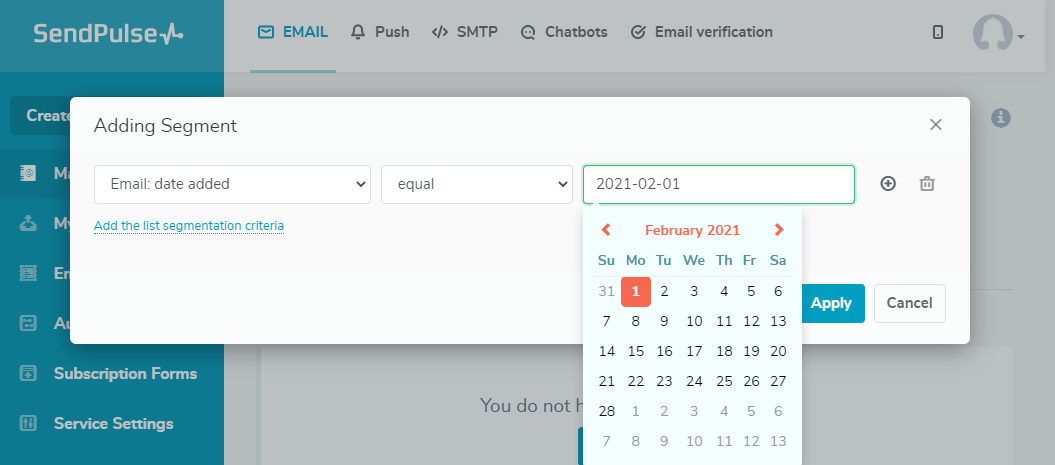
Email: verification status
Use to sort addresses by status after the addresses are checked by a verifier. In the third field, you need to select the status of the address after verification, by which you want to select contacts. You can choose the following statuses:
| Valid address | The email address is active and can receive emails. This address passed the verification for spelling and domain settings. |
| Unconfirmed address | This email address can accept emails, but the domain settings do not allow us to check if the email address is valid or not. |
| Invalid address | The email address does not exist or is inactive at the time of verification. |

Email: in the list of unique
Unique subscribers are contacts whom you have sent emails during the current pricing plan period.
Please note that the segment is considered active if you have sent emails in the current billing period and have contacts in the list of unique subscribers.
Use this option to find unique subscribers in your mailing list. Creating a mailing list with this segment will allow you to create email campaigns without exceeding the overall limit of contacts on the paid plan. You can select two conditions for this segment: = (is) or ≠ (is not) in list.

Presence in another mailing list
Use this option to find duplicates in other mailing lists. In the third field, you need to select the mailing list you want to check against. You can choose the following conditions.
| In list | Will show the addresses that are in the selected mailing list |
| Not in list | Will show all addresses that are not in the selected mailing list. |

To search for duplicate email addresses in multiple mailing lists, use the and operator under the + button.
Phone
Use this option to search for contacts according to conditions corresponding to values of the Phone variable.
You can set the following conditions:
| Contains | Search for contacts with a phone number that contains the numbers you entered; used for partial matches. |
| Equal | Search for contacts with a complete match of the phone number you entered. |
| Not equal | Search for contacts whose phone number does not match the entered value. |
| Starts with | Search for contacts whose phone number begins with the entered digits. Used to select contacts by telecom operator. |
| Ends with | Search for contacts whose phone number ends with the entered digits. |
| Does not contain | Search for contacts whose phone number contains the numbers you entered; used for partial matches. |
| Empty | Search for contacts that do not have a phone number. |
| Not empty | Search for all contacts that have the Phone variable filled. |
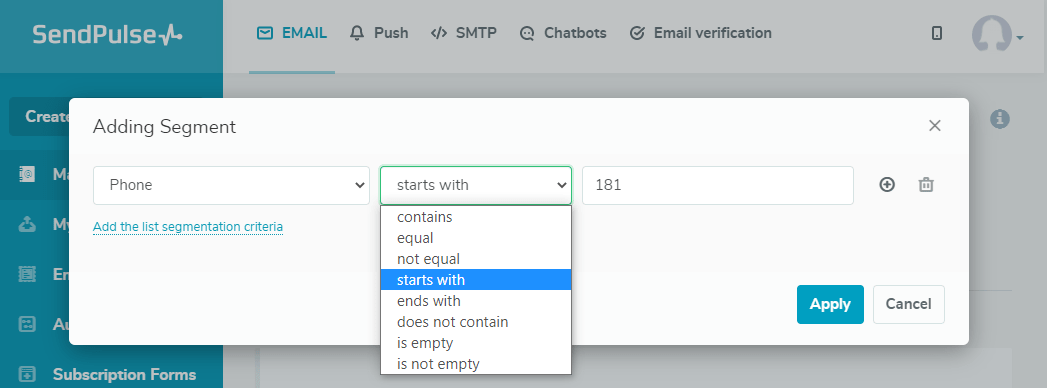
Actions with previous campaigns (opens and clicks from subscribers on the selected mailing list)
Used to track recipient actions such as opens and clicks in the selected mailing list.
You can only use this segment only mailing lists that you have already campaigns to.
To create a campaign, the service uses contact data saved over the past three months.
Select a condition and mailing list from the drop-down list.
Campaigns can have the following statuses:
| Did not open recent emails | Displays all recipients who have not opened the recent emails on the selected mailing list. |
| Opened but did not click a link | Displays all recipients who opened an email but did not follow any of the links. |
| Opened and clicked a link | Displays all recipients who opened an email and followed any link from it. |
| Opened and clicked a specific link | Displays all recipients who opened the mailing list but did not follow the link you specified. Select the required link from those used in the template in the third drop-down list. |
| Received campaign | Displays all recipients who received the selected campaign. |
| Did not receive campaign | Displays all recipients who did not receive the selected campaign. |
| A bot probably opened but did not click a link* | Displays all recipients whose email is likely opened automatically (for example, by an anti-spam bot) without following any links. |
| A bot probably opened and clicked a link* | Displays all recipients whose email is likely opened automatically (for example, by an anti-spam bot) with links followed. |
* This option is available only if the Bot detection feature is active. You can enable it in Service Settings > Other Settings.
Rating and stars
For the segments of this list, only a numeric value is specified. Most of the segmentation parameters are available after sending a request to collect statistics.
Click Submit request to collect statistics. Processing time depends on the number of contacts in the mailing list and the number of campaigns you’ve sent. After finishing the processing of statistics, you will receive an email with (something) and you can start using this segmentation criteria.
Rating
Use the Rating segment to actualize your mailing lists. The number of stars a subscriber has depends on the subscriber's activity - the more campaigns the subscriber opened in the last 60 days, the more stars they will have. You can choose from 0 to 5 stars for your sement.
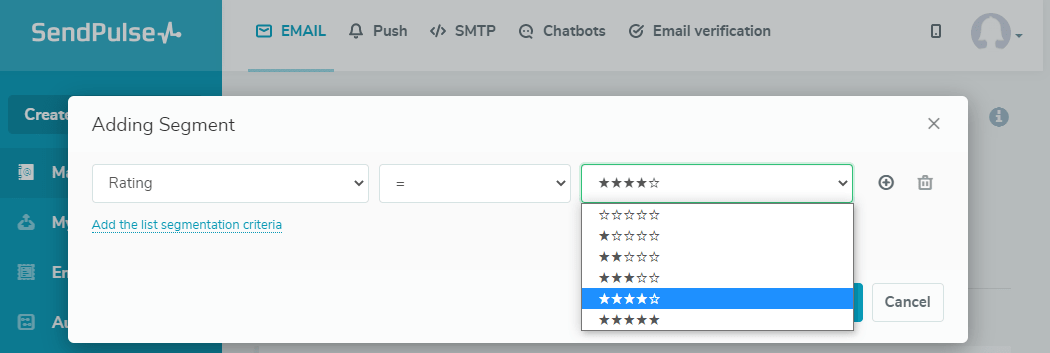
Emails
Search for contacts to whom the specified number of emails were sent in total for the length of their subscription.
Opens
Search for contacts who have opened the specified number of campaigns in total for the length of their subscription.
This method is used to find the most active users, considering that you do not need to track openings for a specific mailing list.
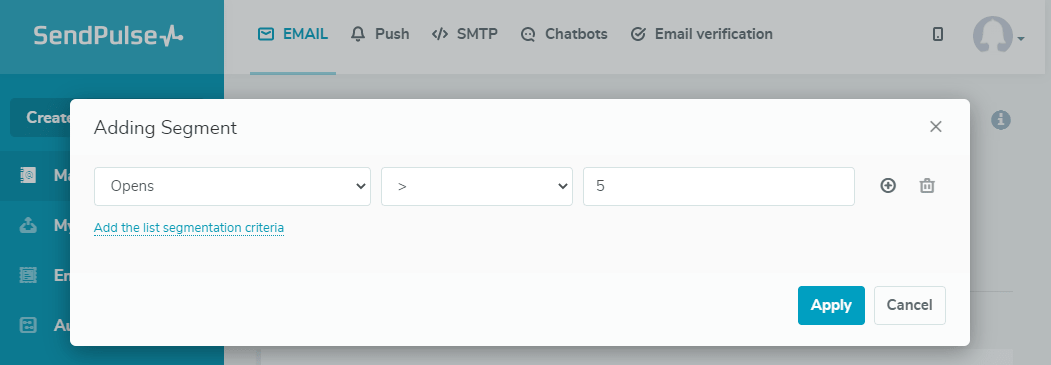
Click-throughs
Search for contacts who followed the specified number of links in all of the campaigns they’ve received from you.
For the Rating, Campaigns, Opens, and Click-through segments you need to indicate the number of stars for the contact, campaigns, opens and clicks in the third field.
You can use following conditions:
| Equal to | Search for contacts, the value of the segment number of which exactly matches the entered value. |
| Not equal | Search for contacts, the value of the segment number does not match the entered value. |
| More than | Search for contacts, the value of the segment number is greater than the entered value. The specified value will not fall within the selection range of the condition. |
| Less than | Search for contacts, the value of the segment number is less than the entered value. The specified value will not fall within the selection range of the condition. |
| Between | Select two values to find contacts whose segment count falls within the selected range. The specified values will also fall within the sampling range. |
Opened recent rmails
Indicate the number of previously opened campaigns. Use the > (greater than) or < (less than operators) for the selected value.
The Opened recent emails selection includes recipients who have opened the specified number of mailings in a row.
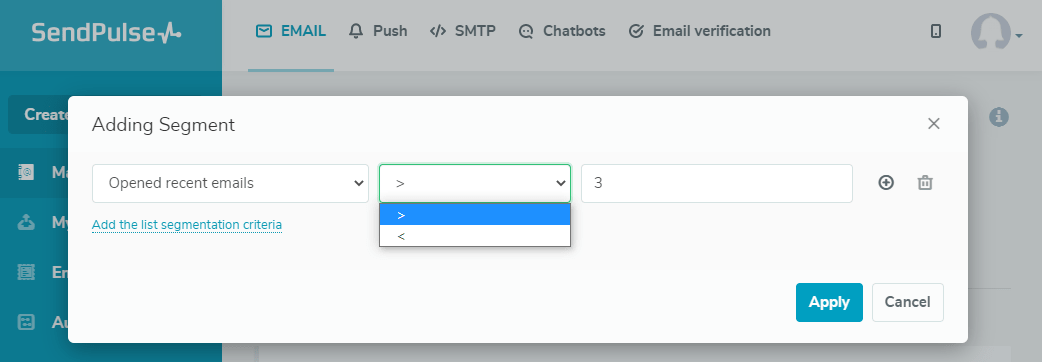
For example, let’s imagine you choose > and 3. As a result, you will receive a list of contacts who have opened more than three campaigns. The operators > (greater than) and < (less than) do not take into account the extreme values that you insert, so only those recipients who have opened four or more mailings will be included in the selection.
Did not open recent emails
Specify the number of recent campaigns a user from your list has not opened. Use the > (greater than) or < (less than) operators for the selected value.
Clicked links in recent emails
Specify the number of recent campaigns from the sent list, in which the recipient followed the links.
Did not click links in recent emails
Specify the number of recent campaigns sent to a given list, in which the user did not click on the links. Use the > (greater than) or< (less than) operators for the selected value.
Opened email from/till date
To use this segment, you need to specify the date before or after which subscribers opened your campaigns.
| Before | Every contact that opened a campaign before the date you enter will be selected. |
| After | Every contact that opened a campaign after the date you enter will be selected. |
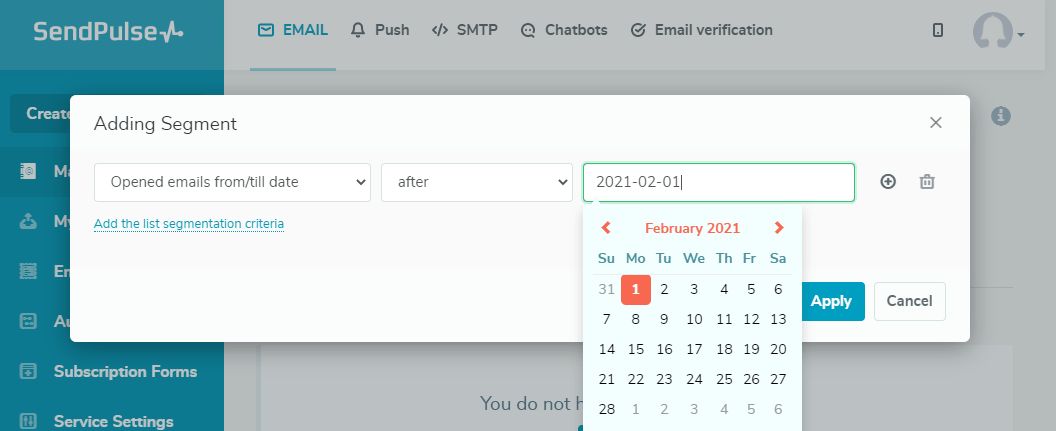
Pay attention to the sampling conditions. If you decide to connect segments of your mailing list with the operator and that opened before Y date and after X date, then you will receive a list of these segments and their values may overlap. It will not equal the time span between date X and date Y.
Didn't open mailings from to date
In this segment, you need to specify the date before or after which users did not open your campaigns.
Clicked links in emails from/till date
In this segment, you need to specify the date before or after which users followed links in any of your campaigns.
Did not click links in emails from/till date
In this segment, you need to specify the date before or after which users did not click on links in any of your campaigns.
Tag
Tags help you organize and segment your audience by tags with additional subscriber information.
In the second field, select the segment condition: whether a specific tag is assigned or not assigned, or whether any tag assigned. In the third, select the tag by which you want to select contacts.

Variables
Variables help you segment your audience based on custom criteria and allow you to create more relevant campaigns for your subscribers. For example, you can segment your mailing list by gender — male and female, preferences — red and blue, region of residence — London and New York.
Also, if you transfer events via our API, in the autoflows you can add the action Copy subscriber with variables or Replace variable for contact immediately after sending “purchase” and “registration” events and pass your data to the variable as the value yes. This data can be used for segmentation.

You can use full or partial match conditions for a specified value. Additionally, you can combine segments with operators for alternative values of the selected variable. In the example below, for this we have chosen the operator or.

Or add related conditions. In the example below, we choose the operator all.
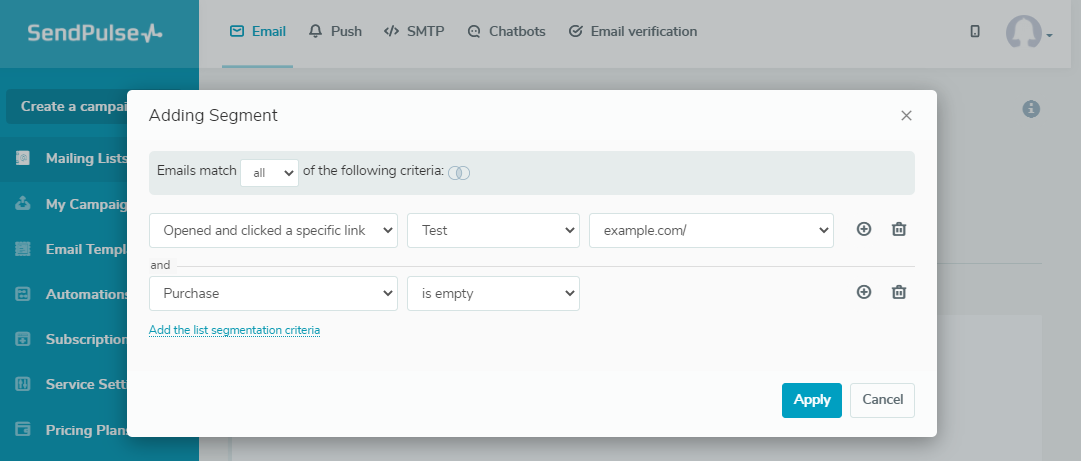
To add a segment by variable, select the variable from the drop-down list, then the condition and value.
The following conditions are available:
| Contains | Search for a subscriber with a variable that contains the value you entered; used for partial matches. |
| Equal | Search for a contact with a complete match of the variable value with the entered value. |
| Not equal | Search for contacts whose variable values do not match the entered value. |
| Starts with | Search for a contact with a variable that starts with the entered value. |
| Ends with | Search for a contact with a variable that ends with the entered value. |
| Does not contain | Search for a contact with a variable value that does not contain the value you entered; used for partial matches. |
| Empty | Search for contacts that lack any value for the given variable. |
| Not empty | Search for contacts in which any value of the selected variable is filled. |
Adding binding operators
And / or
Use the and and or operators to combine conditions for segments of the same type.
For example, imagine that you have selected the variable City and entered the value New York. But you know that you have contacts with the name Peter in your list.
You need to click on the + next to the city value, select the or operator and add another condition and value.

Use the and operator to strictly account for both the first and second conditions. If one of the conditions is not taken into account, then the selection of contacts will not be included in the segment.
Please note the criteria for each condition: the and operator does not replace the between condition for the selected range. For this operator, you will receive a list of contacts that meet the first and second conditions separately.
The or operator is used to match the first or second condition.
All any
If you need to connect several conditions from different types of segments, use the operators all or any.
For example, imagine that you want to select all of the girls on your list named Maria living in the city of Milan.
To do this, select the segment type with the City variable, the equal or contains condition, and the New York value. Then click on Add List Segmentation Condition and select the second segment: type Name, condition equal to or contains and value Maria.
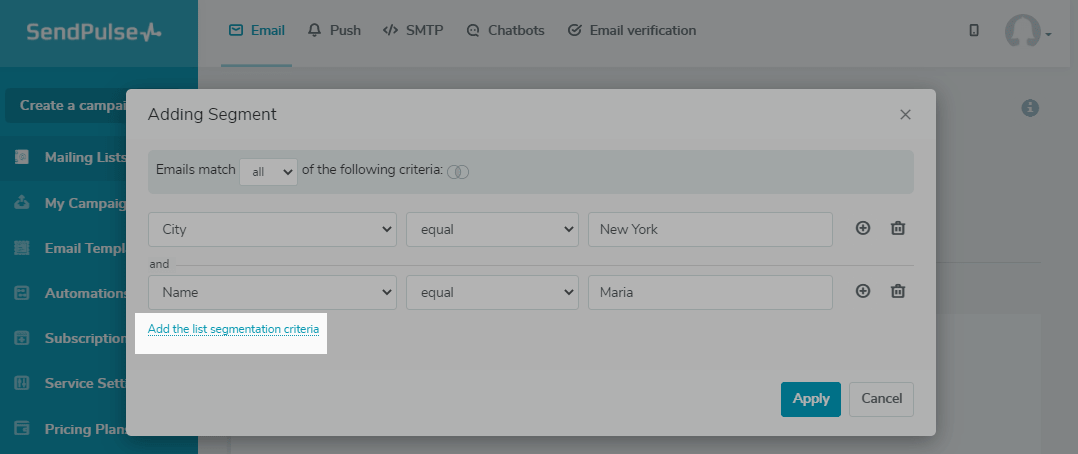
Also, you can use these operators to select active users who generally open your campaigns, but did not open a specific one.
Select the segment type Opens, use the > operator, and enter the value 5. Click on Add segmentation condition for list, select operator for each. Add the second segment Did not open recent emails and select the mailing list from the drop-down list.
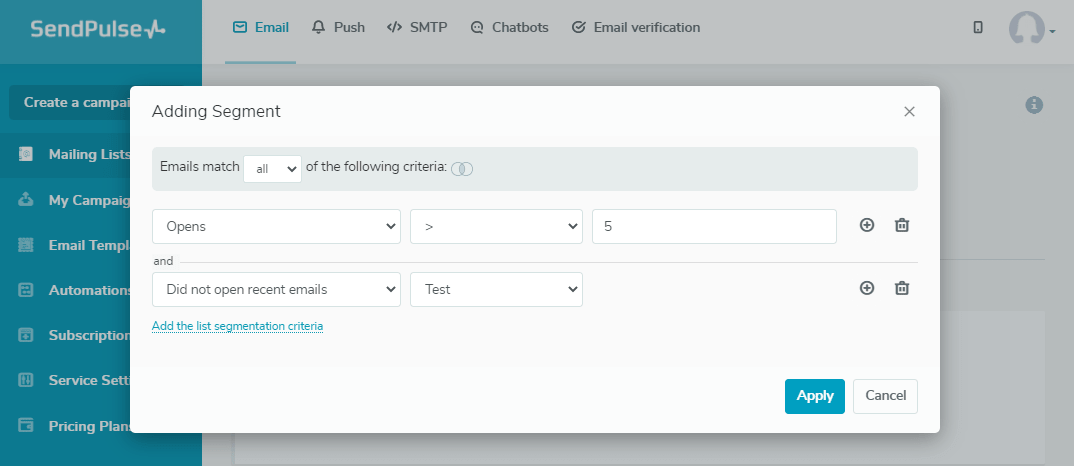
The operator all means that the list will contain contacts that correspond to each of the added segments.
The any operator means that contacts will be added to the list that match any of the added segments.
The difference between all and any from and and or is that in the first case you select different types of segments (for example, the variable Name and the variable City), while in the second case, you select conditions for the same type of segments (for example, the variable Name and several conditions regarding this variable: contains the value of Sasha and contains the value of Alexandra).
Saving and resenting a segment
After adding segments, click Apply and the segment will be created in your mailing list.

Next, enter a name for the segment.
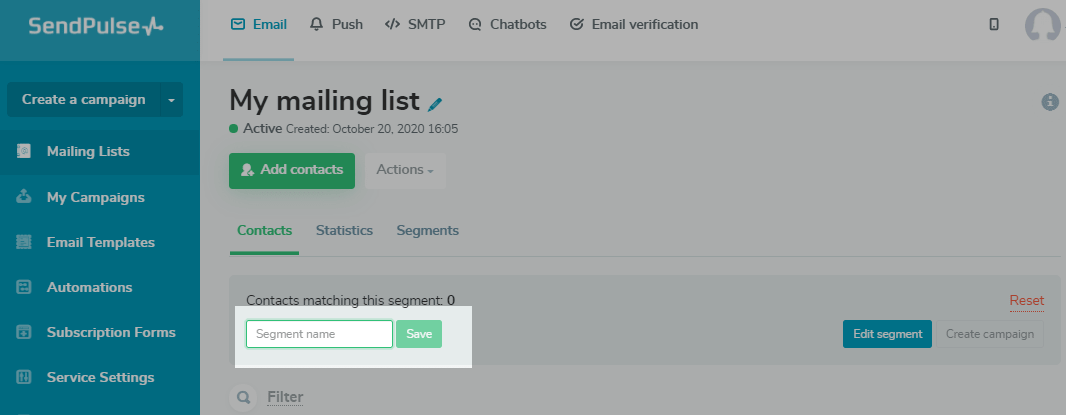
The segment will be saved.
If you do not need to save the segment, click the Reset button.
If the system finds contacts that match your segmentation criteria, they will be displayed in your mailing list.
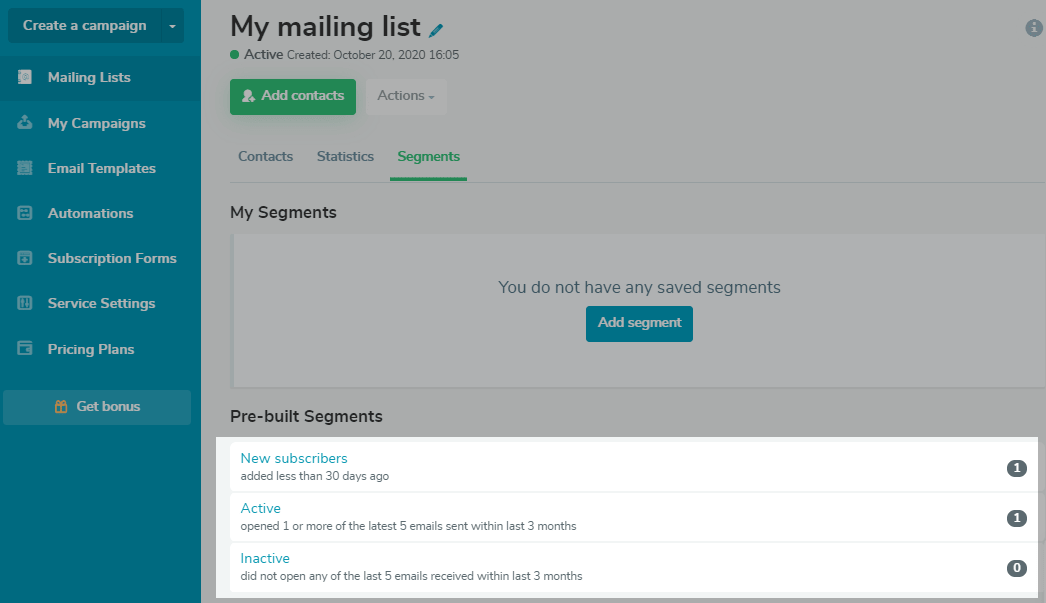
Pre-built segments
Pre-built segments are available in the mailing lists on paid pricing plans. You only need to select the desired segment.
| New subscribers | Will select all subscribers added within the last 30 days. |
| Active | Will select all subscribers who opened emails from the last five campaigns sent in the last three months. |
| Inactive | Will select all subscribers who have not opened any of the last five campaigns sent in the last three months. |
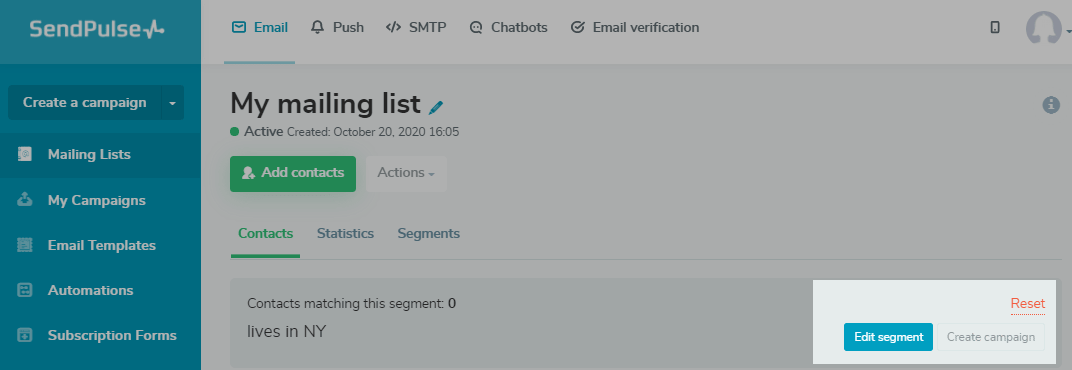
Manage created segments
Edit a segment
Click Edit Segment to change the condition or type of segment.
Create a campaign
Click Create a campaign and you will be redirected to the email campaign builder. The recipients will be contacts from the selected segment of this mailing list.
Saved segments are also available when creating campaigns. Segments can be applied to each mailing list individually.
Delete a segment
Go to the Segments tab and click on the trash can icon opposite the segment you want to delete. This action will only delete the segment criteria, the contacts corresponding to the segment will remain in the mailing list.
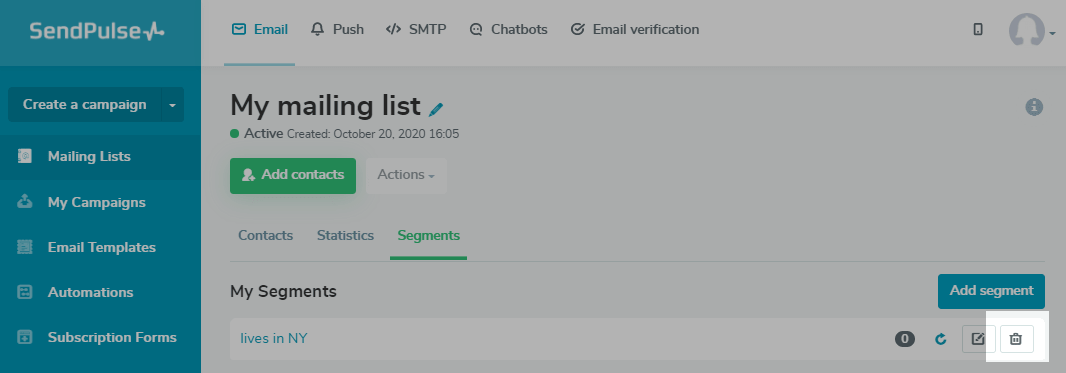
Actions with contacts inside a segment
You can only perform actions on segments that contain subscribers from the selected mailing list.
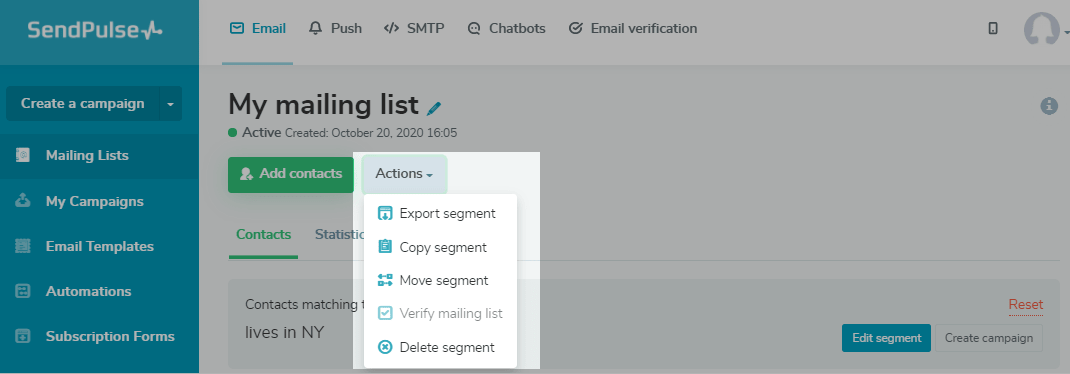
Export a segment
Click the Actions button and select Export segment to export contacts to a CSV, XLS, XLSX file.

Copy a segment
Click Actions button and select Copy Segment to copy your subscribers to another mailing list. At the same time, subscribers in the current mailing list will be saved.
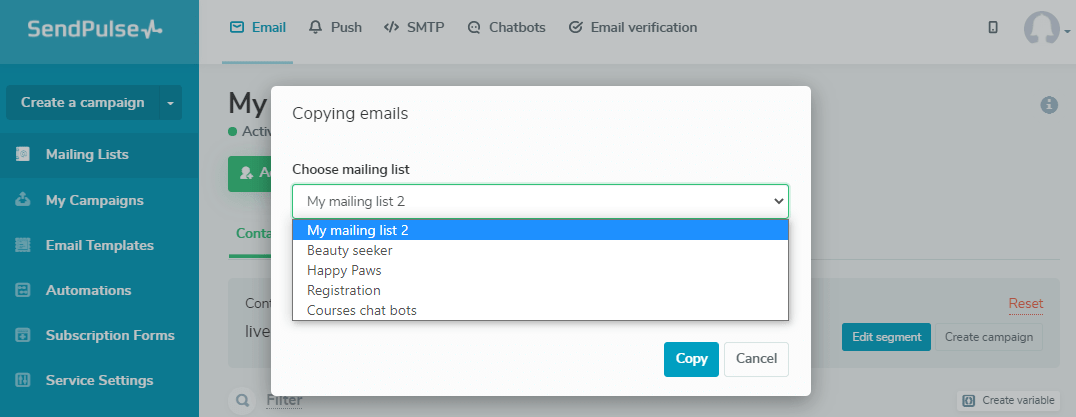
Move a segment
Click the Actions button and select Move Segment to move the subscribers to another mailing list. In this case, contacts in the current mailing list will be deleted
Delete a segment and remove contacts
Click the Actions button and select Delete Segment to remove contacts from the selected mailing list.

With a free plan, you can only delete a segment, contacts are not deleted from your mailing list.
Last Updated: 08.02.2024

or